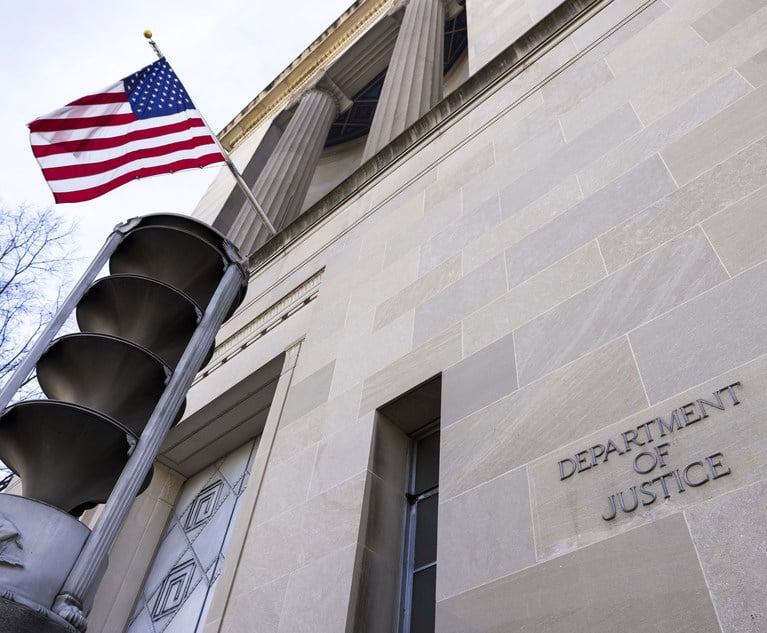Connecticut Maintains Hard Line in Enforcing Governmental Immunity
Governmental immunity is alive and well on Connecticut school grounds this year.
April 13, 2018 at 05:22 PM
5 minute read

Governmental immunity is alive and well on Connecticut school grounds this year. Two cases, one from the Appellate Court and another from the Supreme Court, are enforcing a hard line on the identifiable person/imminent harm exception to the defense of governmental immunity.
The exception in question dates back to 1979 in Sestito v. Groton, where a police officer did not intervene in a public disturbance until after the plaintiff's decedent was shot and killed. The case involved conflicting testimony as to the imminence of the harm to the plaintiff's decedent. The court held the question of imminence should have been submitted to the jury, not decided by the trial court on a motion for directed verdict. (1)
From Sestito, we saw the beginning of an exception to governmental immunity: a duty to act exists when it would be apparent to a public officer that his failure to act would likely subject an identifiable person to imminent harm. A public officer could be liable for a failure to act under that circumstance.
At its core, the exception requires three elements: 1) an imminent harm; 2) an identifiable victim; and 3) a public official to whom it is apparent that his conduct is likely to subject the victim to the harm. Over time, the identifiable person was expanded to include “narrowly identified classes of foreseeable victims.” (2) In practice, the only class this is applied to are schoolchildren attending public schools during school hours. Also, in recent years, the standard for determining “imminence” was redefined as to whether it was apparent to the defendant that the danger was so likely to cause harm that they had a clear and unequivocal duty to act. (3)
McCarroll v. East Haven, an appellate decision released on March 23, involves a child injured during elementary school recess when he fell from a ladder at the playground. The injury allegedly occurred due to the decrepit condition of the ladder the student was climbing. The defendant filed a motion for summary judgment on the ground that the defendant was entitled to governmental immunity and the identifiable victim/imminent harm exception did not apply.
The Appellate Court held the plaintiff in McCarroll failed to prove the harm was imminent. The plaintiff argued the playground was visibly decrepit to prove the danger was apparent to the defendant. But there was insufficient evidence that the dangerous condition of the bolt on the ladder rung (the alleged danger that caused the fall) was apparent to the defendant. (4)
The holding in McCarroll strengthens governmental immunity by confining the identifiable person/imminent harm exception. It forces plaintiffs to demonstrate an actual awareness of the specific dangerous condition that causes of the injury. A general awareness of danger in a given area is not sufficient.
Earlier this year, in Martinez v. New Haven, the Supreme Court reversed a trial court decision relying on the identifiable person/imminent harm exception. The plaintiff, a student at school during school hours, was injured by another student running with scissors, who dropped the scissors, and, while picking them up, accidentally cut the plaintiff's face. In a bench trial, the court determined the plaintiff proved the identifiable person/imminent harm exception applied and rendered a judgment of $40,814.19. (5)
On appeal, the defendants argued the plaintiff was not an identifiable person subject to imminent harm because the court: 1) did not identify how the harm was imminent, 2) did not identify the dangerous condition or how it was apparent to the defendant; and 3) improperly relied on whether the harm was foreseeable.
Justice Richard Robinson, writing for the majority, concluded the plaintiff failed to prove imminence: that it was apparent to the defendants that a student running with safety scissors was so likely to cause harm that a clear and unequivocal duty to act immediately was created. The defendant teacher did not see the students in question or the scissors (as he was tending to other students at the time) and the court found no rule against students possessing safety scissors or any history of student behavior problems.
The court reversed the trial court's judgment and remanded the case with instruction to enter judgment for the defendant. Notably, Justice Dennis Eveleigh's dissent seems to argue a standard for imminence where the question is what should have been apparent rather than what was apparent to the teacher on duty.
In a footnote, the court remarks “the question of whether an imminent harm was apparent to a municipal defendant is an evolving area of the law,” foreshadowing to future decisions. Though these cases do not make any changes to the exception, the courts could have squeezed them into the exception if they really wanted to. Given the court's comment, we will likely see similar cases throughout the year and maybe even some changes to the exception.
Cases cited: Sestito v. Groton, 178 Conn. 520 (1979); Burns v. Board of Education, 228 Conn. 640 (1994); Haynes v. Middletown, 298 Conn. 907 (2014); McCarroll v. East Haven, (AC 39260); Martinez v. New Haven, (SC 19850).
Ron Houde is an attorney with The Kalon Law Firm in Hartford, defending a wide range of civil claims brought against public entities and municipalities in Connecticut. He practices in state, federal and tribal courts.
This content has been archived. It is available through our partners, LexisNexis® and Bloomberg Law.
To view this content, please continue to their sites.
Not a Lexis Subscriber?
Subscribe Now
Not a Bloomberg Law Subscriber?
Subscribe Now
NOT FOR REPRINT
© 2025 ALM Global, LLC, All Rights Reserved. Request academic re-use from www.copyright.com. All other uses, submit a request to [email protected]. For more information visit Asset & Logo Licensing.
You Might Like
View All
Big Law Practice Leaders Gearing Up for State AG Litigation Under Trump
4 minute read
A Look Back at High-Profile Hires in Big Law From Federal Government
4 minute read
Legal Departments Gripe About Outside Counsel but Rarely Talk to Them
4 minute read
Government Attorneys Are Flooding the Job Market, But Is There Room in Big Law?
4 minute readTrending Stories
- 1Settlement Allows Spouses of U.S. Citizens to Reopen Removal Proceedings
- 2CFPB Resolves Flurry of Enforcement Actions in Biden's Final Week
- 3Judge Orders SoCal Edison to Preserve Evidence Relating to Los Angeles Wildfires
- 4Legal Community Luminaries Honored at New York State Bar Association’s Annual Meeting
- 5The Week in Data Jan. 21: A Look at Legal Industry Trends by the Numbers
Who Got The Work
J. Brugh Lower of Gibbons has entered an appearance for industrial equipment supplier Devco Corporation in a pending trademark infringement lawsuit. The suit, accusing the defendant of selling knock-off Graco products, was filed Dec. 18 in New Jersey District Court by Rivkin Radler on behalf of Graco Inc. and Graco Minnesota. The case, assigned to U.S. District Judge Zahid N. Quraishi, is 3:24-cv-11294, Graco Inc. et al v. Devco Corporation.
Who Got The Work
Rebecca Maller-Stein and Kent A. Yalowitz of Arnold & Porter Kaye Scholer have entered their appearances for Hanaco Venture Capital and its executives, Lior Prosor and David Frankel, in a pending securities lawsuit. The action, filed on Dec. 24 in New York Southern District Court by Zell, Aron & Co. on behalf of Goldeneye Advisors, accuses the defendants of negligently and fraudulently managing the plaintiff's $1 million investment. The case, assigned to U.S. District Judge Vernon S. Broderick, is 1:24-cv-09918, Goldeneye Advisors, LLC v. Hanaco Venture Capital, Ltd. et al.
Who Got The Work
Attorneys from A&O Shearman has stepped in as defense counsel for Toronto-Dominion Bank and other defendants in a pending securities class action. The suit, filed Dec. 11 in New York Southern District Court by Bleichmar Fonti & Auld, accuses the defendants of concealing the bank's 'pervasive' deficiencies in regards to its compliance with the Bank Secrecy Act and the quality of its anti-money laundering controls. The case, assigned to U.S. District Judge Arun Subramanian, is 1:24-cv-09445, Gonzalez v. The Toronto-Dominion Bank et al.
Who Got The Work
Crown Castle International, a Pennsylvania company providing shared communications infrastructure, has turned to Luke D. Wolf of Gordon Rees Scully Mansukhani to fend off a pending breach-of-contract lawsuit. The court action, filed Nov. 25 in Michigan Eastern District Court by Hooper Hathaway PC on behalf of The Town Residences LLC, accuses Crown Castle of failing to transfer approximately $30,000 in utility payments from T-Mobile in breach of a roof-top lease and assignment agreement. The case, assigned to U.S. District Judge Susan K. Declercq, is 2:24-cv-13131, The Town Residences LLC v. T-Mobile US, Inc. et al.
Who Got The Work
Wilfred P. Coronato and Daniel M. Schwartz of McCarter & English have stepped in as defense counsel to Electrolux Home Products Inc. in a pending product liability lawsuit. The court action, filed Nov. 26 in New York Eastern District Court by Poulos Lopiccolo PC and Nagel Rice LLP on behalf of David Stern, alleges that the defendant's refrigerators’ drawers and shelving repeatedly break and fall apart within months after purchase. The case, assigned to U.S. District Judge Joan M. Azrack, is 2:24-cv-08204, Stern v. Electrolux Home Products, Inc.
Featured Firms
Law Offices of Gary Martin Hays & Associates, P.C.
(470) 294-1674
Law Offices of Mark E. Salomone
(857) 444-6468
Smith & Hassler
(713) 739-1250










